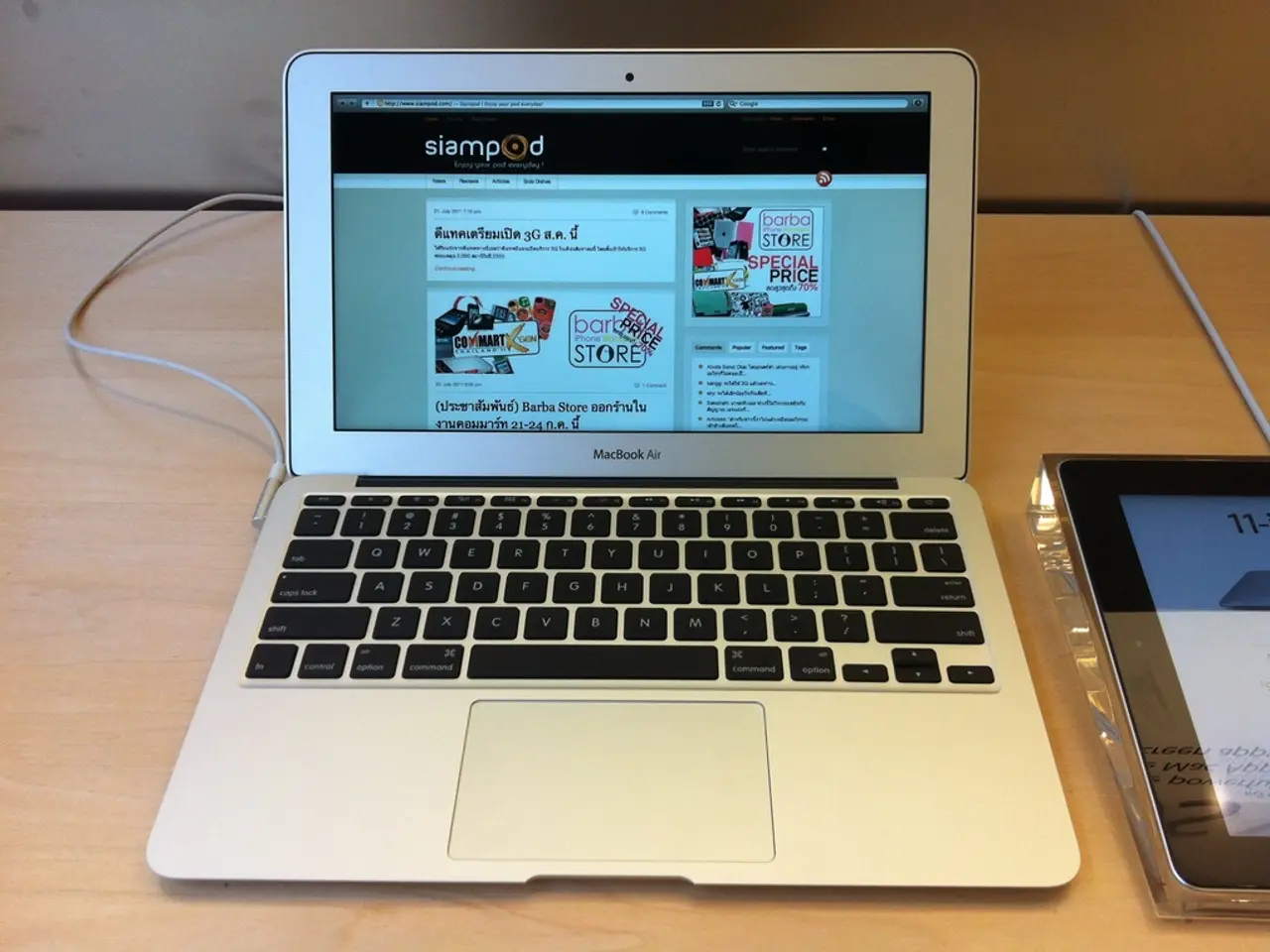Guide on Developing a Protected Application in Australia by 2025: Essential Insights Revealed
In today's interconnected world, mobile apps have become the cornerstone of modern business, powering sectors ranging from banking and healthcare to retail and government services. However, this digital revolution comes with a dark side: escalating cyberattacks.
Data breaches cost businesses dearly, shaking customer trust, draining profits, and tarnishing reputations in an instant. The numbers don't lie. In 2023-24, the Australian Signals Directorate (ASD) recorded over 87,400 cybercrime reports, with identity fraud being the most common type. Meanwhile, 69% of Australian businesses experienced a ransomware attack in 2024, up from 56% in 2023.
Such incidents take a heavy toll on the financial side of businesses. According to Security Brief Australia, 91% of Australian small business owners reveal that cybercrime costs them approximately AUD $300 million annually. And the average cost per cybercrime report in 2022-23 was $97,200 for mid-sized businesses, $71,600 for large companies, and $46,000 for small businesses. That's a 14% overall increase from 2021-22.
Recognizing the looming threat, the Australian government unveiled the Cyber Security Strategy 2023-2030, a long-term plan aimed at turning Australia into a global cyber resilience powerhouse. For developers and businesses, this means that security can no longer be an afterthought.
Whether you're building a fintech app, a healthcare platform, or a government service portal, you're not just shipping features; you're dealing with people's most sensitive data, and they expect you to treat it like gold.
This guide will help you build mobile apps in Australia that are secure by design, from nailing compliance requirements to embedding strong security practices into your development lifecycle. We'll walk through the right tools, proven frameworks, and real-world tactics to help you develop apps that don't just function, but earn trust.
Secure Coding Practices
Want to know if your app can withstand it? Request a Free App Security Assessment.
$1,000 - $3,000
Navigating Australia's Regulatory Environment:
To build a secure app in Australia, developers must delve beyond technical protections and closely adhere to an expanding web of national cybersecurity and privacy laws. Australia has enacted some of the world's most progressive data security and cybersecurity legislation, so mobile apps in compliance with Australian regulations are a crucial metric for trust and sustainability.
Basic Authentication
Privacy Act 1988 & Australian Privacy Principles (APPs)
$1,500 - $4,000
At the heart of mobile app security and compliance in Australia is the Privacy Act 1988. The Act and the 13 Australian Privacy Principles (APPs) govern the collection, handling, storage, and disclosure of personal information. For any mobile app that deals with user data, adherence to the APPs is non-negotiable.
Cyber Security Bill 2024 (Cth)
SSL/TLS Encryption
Part of the overall Australian Cyber Security Strategy 2023-2030, this bill lays down a standalone framework for cybersecurity. It imposes requirements on critical infrastructure sectors and digital services, such as mobile applications, to establish proactive security strategies and undergo regular application security testing.
$500 - $1,500
Consumer Data Right (CDR)
The CDR empowers consumers to share their data securely between service providers. Any developer looking to make a secure Australian app in the banking, energy, or telecom industries must support data portability and safeguard consumer information with airtight encryption and access control.
Basic Vulnerability Scanning
The Essential Eight from ACSC
$1,000 - $3,500
Instituted by the Australian Cyber Security Centre (ACSC), the Essential Eight measures are aimed at limiting the possibility of cyber threats. They incorporate steps like application whitelisting, patch management, and multi-factor authentication, which are essential features in the application security framework in Australia.
Compliance Isn't Optional:
Compliance with Basic Standards
For companies and app developers, non-compliance results in class action lawsuits, damage to reputation, and regulatory fines. The cost to build a secure app in Australia is far less than that of data breaches or fines. Therefore, incorporating compliance strategies for Australian businesses early in the app development process isn't just a smart move, it's necessary.
$1,000 - $4,000
Incorporating these laws and frameworks early in your roadmap ensures you're not just building functional apps, but designing secure Australian apps that meet the legal requirements for launching your mobile app.
Core Features for Ensuring App Security:
Building a modern app isn't just about user-friendly interfaces and performance; it's about security, by default, and by design. To develop a secure app in Australia, your architecture must include a set of non-negotiable security-first features that protect sensitive data, enable compliance, and safeguard user trust.
Here are the essential secure app development features every Australian app should include:
End-to-End Encryption
App Complexity
Encryption is the first line of defense for whatever you're dealing with, whether it's login credentials, financial information, or health data. End-to-end encryption secures data in transit and at rest, rendering it unintelligible to all parties except the final recipient, even if intercepted.
Low ($500 - $2,000)
Multi-Factor Authentication (MFA)
Adding more levels of identity verification is among the mobile app's best practices to ensure safety and security. Businesses implement MFA, especially through biometrics like facial recognition or fingerprint verification, substantially reducing the risk of unauthorized access to user accounts.
Third-Party Tools
Role-Based Access Control (RBAC)
Medium ($1,000 - $3,000)
RBAC ensures that users can only access parts of your app that they have permission to. This limits the exposure of sensitive information and is critical for industries with strict regulatory regimes, such as finance, health, and government services.
Secure APIs with Token-Based Authentication
Team Expertise
APIs are common targets for attacks and must be proactively secured. Use HTTPS, OAuth 2.0, and access tokens to ensure APIs talk only to approved users and systems. This is especially important in apps that contain third-party integration or allow data sharing under the Consumer Data Right (CDR).
Medium ($1,000 - $4,000)
Encryption at Rest and In Transit
Data isn't just vulnerable when it's moving. It must also be encrypted when stored on devices or in the cloud. Incorporating both types of encryption helps design secure Australian apps that meet the requirements of the application security framework in Australia.
Audit Logging and Monitoring
Track all user actions and system activities with robust application security monitoring. Detailed logs can detect anomalies, support threat forensics, and help demonstrate compliance during audits. They also allow for faster incident response, minimising the impact of potential breaches.
Emerging Security Trends in Australia in 2025:
Threat Modeling and Risk Assessment
In 2025, secure mobile app development is being redefined by five major shifts that are shaping the future of application security in Australia and globally. Keeping pace with the latest security trends is no longer a choice; it's mission-critical.
$5,000 - $15,000
AI-Driven Threats and Defenses
The rising of AI-powered malware makes attacks faster, more targeted, and harder to detect. AI-based cybersecurity solutions are now being incorporated into mobile app platforms. They provide real-time threat detection and response, enabling developers and security teams to counter threats as they emerge actively.
Advanced Authentication and Authorization
Cloud Security Enhancements
$5,000 - $20,000
With most mobile apps leveraging cloud backends, cloud security risk management is now essential. Cloud Security Posture Management (CSPM) tools continuously evaluate cloud environments for misconfigurations and policy violations. In parallel, the emphasis is rising on securing APIs and managing machine identities-key considerations for building mobile apps in compliance with Australian regulations.
DevOps Integration
End-to-End Encryption
Gone are the days when security was an end-of-line checklist. Now, devOps for businesses ensures security is built in from day one. This means ongoing security scanning, automated code analysis, and ahead-of-time compliance monitoring down the CI/CD pipeline. It's a defining principle of secure app development in Australia, enabling speed and safety without compromise.
$3,000 - $10,000
Software Supply Chain Security
Third-party dependencies are a major risk vector. In 2025, transparency and traceability through Software Bill of Materials (SBOMs) will be the focus. These documents list every software used in your app so developers can easily find and fix vulnerabilities. For teams aiming to design secure Australian apps, monitoring third-party components and supply chains is now a non-negotiable practice.
Penetration Testing
Post-Quantum Cryptography
$5,000 - $25,000
Quantum computing, while still in its infancy, is a grave threat to classical encryption practices. Progressive developers, particularly those creating apps in finance, defence, or healthcare, are already using quantum-resistant algorithms to future-proof their systems.
Application Security Posture Management (ASPM)
Secure DevOps (SecDevOps)
Application Security Posture Management (ASPM) is a newer trend that is catching on in Australia. It enables developers to consolidate security information, compliance metrics, and risk indicators into a single dashboard, making decisions faster and reducing blind spots.
$5,000 - $20,000
How to build a secure app in Australia: Secure App Development Lifecycle in Australia:
To build a secure app in Australia, security must be woven into each application development life cycle stage, not added as an afterthought. It's not merely a matter of code, but of mindset, governance, and strategy for the long term. Here's how to build a secure app in Australia, step by step:
Regulatory Compliance
Planning and Design: Security by Default
$10,000 - $30,000
Security begins at the whiteboard. At the planning stage, architects and developers must include security requirements, such as threat modeling, data protection policies, and adherence to legislation such as the Privacy Act 1988 and Cyber Security Bill 2024. This initial step secures user data in app development.
Development: Secure Code Practices
Vulnerabilities often creep in during the development stage. To prevent injection attacks, use secure coding practices like input validation, sanitization, and version control. Practice secure coding techniques, peer review, and minimize third-party dependency.
Testing: Identify Before Exploit
Testing isn't a one-time task; it's a continuous defense layer. Use static and dynamic application security testing (SAST and DAST), conduct regular penetration testing, and leverage specialized solutions that align with your compliance strategies for Australian businesses. This phase is critical, especially for regulated industries, to ensure the app meets all required security standards before deployment.
App Scale
Deployment: Hardened Environments
High ($10,000 - $30,000)
Once the app is ready to go live, it needs to be deployed with security settings in place. This comprises API token encryption, HTTPS enforcement, multi-factor authentication (MFA), and securely managing secrets. Whether cloud or on-prem, ensure the infrastructure complies with the application security framework in Australia.
Maintenance: Continuous Vigilance
Regulatory Requirements
Security doesn't end at launch. Your team must implement application security monitoring, release regular patches, manage updates, and monitor for zero-day vulnerabilities. This is especially vital when aiming to keep mobile apps in compliance with Australian regulations over time.
Very High ($15,000 - $40,000)
Don't screw your users or tank your reputation. Build a bulletproof, compliance-ready app with Appinventiv.
Cost Considerations for Secure App Development
Custom Security Solutions
Cost is often a key concern regarding secure app development in Australia. Although security may appear to be an additional expense initially, the long-term benefits of building secure apps in Australia-protection against data breaches, compliance with the law, and continued user trust-greatly exceed the investment.
High ($8,000 - $25,000)
The cost to build a secure app in Australia ranges from $5,000 to $20,000 (AUD 7800 to AUD 30,600) for Basic security. This level is suitable for small-scale applications with minimal sensitive data, such as personal productivity apps or informational platforms.
For $50,000 to $100,000 (AUD 78,000 to AUD 1,54,000), Advanced security level is recommended. This tier addresses the needs of complex fintech, healthcare, and e-commerce apps, offering comprehensive protection in high-risk environments.
Ongoing Maintenance
Strategies to Mitigate Security Risks Effectively:
Medium ($5,000 - $20,000)
Security is no longer reactive; it's a proactive discipline embedded into every stage of development. If you aim to make a secure Australian app, it's essential to adopt strategies that reduce vulnerabilities before they become threats.
Adopt a Minimum Viable Security (MVS) Approach
Building an MVP-like approach to security ensures essential protections are in place from day one. By identifying baseline security requirements and gradually scaling protections, teams can develop secure Australian apps without stalling innovation or go-to-market timelines.
Use Trusted Open-Source Security Tools
Open-source doesn't mean insecure. Many vetted tools are widely trusted for application security testing, encryption, and vulnerability scanning. Leveraging these tools within your stack keeps costs in check while strengthening your app's defenses.
Automate Security Testing in CI/CD Pipelines
Integrating security into your DevOps workflow-known as DevSecOps-ensures continuous risk mitigation. Automated scans, code reviews, and policy checks embedded in your CI/CD pipeline can identify and resolve threats early, reducing last-minute production issues.
Prioritize Regular Updates and Patch Management
Cyber threats evolve, and so should your app. One of the most overlooked components of building a secure app in Australia is timely patching. Whether it's a vulnerability in your codebase or third-party components, consistent updates are critical to protecting user data and staying compliant with Australian regulations.
Train Your Development Teams on Security
Often, security breaches stem from oversight. Conducting security awareness training equips developers to write secure code, recognize red flags, and understand emerging threats. This cultural shift is essential to maintaining security-first mobile apps.
Appinventiv builds bulletproof, scalable apps with full-on protection. Grab your quote for hardcore security!
Challenges in Building Secure Apps & Solutions
As the demand for secure mobile app development in Australia grows, so do the challenges. Addressing these head-on is key to building reliable, regulation-ready apps.
Rapidly Evolving Threat Landscape
Cyber attackers constantly refine their methods. New attack vectors-particularly those powered by AI-require developers to implement adaptive defenses.
Balancing UX and Security
Users want frictionless experiences, but security often introduces layers-think MFA, permissions, and encryption. The challenge is to design secure Australian apps without compromising performance or usability.
Multi-Jurisdictional Compliance
For companies targeting local and international markets, aligning with mobile app security and compliance in Australia and GDPR or HIPAA can be tricky. Having a flexible, modular approach to compliance helps meet diverse security challenges specific to mobile apps.
Cybersecurity Talent Shortage
Australia lacks skilled cybersecurity workers because there are not enough professionals to handle the rising need for securing digital systems like mobile apps. As online attacks become more advanced, businesses need people who can plan, build, and manage strong security solutions. To close this gap, many businesses turn to outside help or invest resources in training their teams.
Solutions:
- Collaborate with experienced cybersecurity firms like Appinventiv to ensure your app is designed and developed with robust security measures in place.
- Educate and upskill in-house teams to address the talent gap.
- Implement automation and DevSecOps practices to accelerate threat detection and response, reducing the need for manual intervention.
- Leverage trusted open-source tools and frameworks to manage cyber risks within budget constraints.
Building a secure app in Australia requires a holistic approach that combines technical expertise, ongoing vigilance, and a proactive mindset towards security. By embracing these strategies, Australian businesses can mitigate security risks effectively and build apps that are trustworthy, reliable, and future-proof.
Machine learning algorithms can be employed to identify patterns and anomalies in app usage, bolstering the security of mobile apps in Australia. In the context of cybersecurity, machine learning can serve as an advanced tool for threat modeling and risk assessment.
Adopting cloud services can facilitate compliance with the Consumer Data Right (CDR) and other data security legislation in Australia. Cloud services enable secure data storage, transmission, and management, supporting the development of secure Australian apps.
During mobile app development in Australia, it's essential to prioritize sports-related apps' security, not only from a financial or data perspective but also to maintain user trust and adhere to privacy laws. Implementing encryption, multi-factor authentication, and other secure app development features can help make sports apps secure by design.








